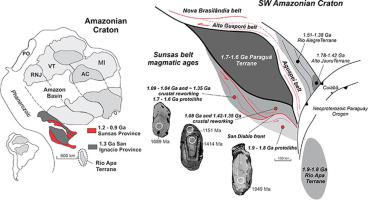Geoscience Frontiers ( IF 8.9 ) Pub Date : 2021-06-05 , DOI: 10.1016/j.gsf.2021.101247 Ingrid M. Nedel , Reinhardt A. Fuck , Amarildo S. Ruiz , Gerardo R. Matos-Salinas , Alanielson da C.D. Ferreira

|
We present new U–Pb zircon and monazite ages from the Sunsas belt granitic magmatism in Bolivia, SW Amazonian Craton. The geochronological results revealed four major magmatic events recorded along the Sunsas belt domains. The older igneous event formed a granitic basement coeval to the Rio Apa Terrane (1.95 – 1.85 Ga) in the southern domain. The second magmatic episode is represented by 1.68 Ga granites associated to the Paraguá Terrane (1.69–1.66 Ga) in the northern domain. The 1.37–1.34 Ga granites related to San Ignacio orogeny represent the third and more pervasive magmatic event, recorded throughout the Sunsas belt. Moreover, magmatic ages of ~1.42 Ga revealed that the granitogenesis associated to the Santa Helena orogeny also affected the Sunsas belt, indicating that it was not restricted to the Jauru Terrane. Lastly, the 1.10–1.04 Ga youngest magmatism was developed during the Sunsas orogeny and represents the final magmatic evolution related to Rodinia assembly. Likewise, the 1.95–1.85 and 1.68 Ga inherited zircon cores obtained in the ~1.3 Ga and 1.0 Ga granite samples suggest strong partial melting of the Paleoproterozoic sources. The 1079 ± 14 Ma and 1018 ± 6 Ma monazite crystallization ages can be correlated to the collisional tectono-thermal event of the Sunsas orogeny, associated to reactions of medium- to high-grade metamorphism. Thus, the Sunsas belt was built by heterogeneous 1.95–1.85 Ga and 1.68 Ga crustal fragments that were reworked at 1.37–1.34 Ga and 1.10–1.04 Ga related to orogenic collages. Furthermore, the 1.01 Ga monazite age suggests that granites previously dated by zircon can bear evidence of a younger thermal history. Therefore, the geochronological evolution of the Sunsas belt may have been more complex than previously thought.
中文翻译:

Sunsas 带、玻利维亚前寒武纪地盾、西南亚马逊克拉通的元古代岩浆活动时间
我们展示了来自西南亚马逊克拉通玻利维亚 Sunsas 带花岗岩岩浆作用的新 U-Pb 锆石和独居石年龄。地质年代学结果揭示了沿 Sunsas 带域记录的四个主要岩浆事件。较老的火成岩事件形成了与南部地区的 Rio Apa Terrane (1.95 – 1.85 Ga) 同期的花岗岩基底。第二个岩浆事件由与北部区域的巴拉瓜地体(1.69-1.66 Ga)相关的 1.68 Ga 花岗岩代表。与圣伊格纳西奥造山运动相关的 1.37-1.34 Ga 花岗岩代表了第三次和更普遍的岩浆事件,记录在整个 Sunsas 带。此外,~1.42 Ga 的岩浆年龄表明,与圣赫勒拿造山运动相关的花岗岩形成也影响了 Sunsas 带,表明它不仅限于 Jauru Terrane。最后,1.10-1。04 Ga 最年轻的岩浆活动是在 Sunsas 造山运动期间发展起来的,代表了与 Rodinia 组合相关的最终岩浆演化。同样,在~1.3 Ga 和1.0 Ga 花岗岩样品中获得的1.95-1.85 和1.68 Ga 继承锆石核表明古元古代源的强烈部分熔融。1079 ± 14 Ma 和 1018 ± 6 Ma 独居石结晶年龄可能与 Sunsas 造山运动的碰撞构造热事件相关,与中至高级变质作用的反应有关。因此,Sunsas 带是由异质的 1.95-1.85 Ga 和 1.68 Ga 地壳碎片构成的,这些碎片在 1.37-1.34 Ga 和 1.10-1.04 Ga 处与造山拼贴有关。此外,1.01 Ga 独居石年龄表明以前用锆石测年的花岗岩可以提供更年轻的热历史证据。所以,


























 京公网安备 11010802027423号
京公网安备 11010802027423号